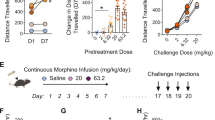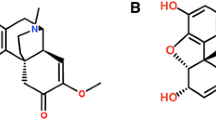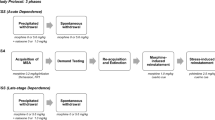Abstract
Rationale
Behavioral sensitization induced by repeated morphine administrations may depend on patterns of administration. However, neurobiological mechanisms involved in this sensitization are largely unknown.
Objectives
We compared the effects of intermittent (20 mg/kg, once daily for 7 days) and chronic (escalating doses from 5 to 40 mg/kg, three times a day for 5 days) morphine treatments in mice on locomotor activity. We also quantified, by autoradiography, mu opioid receptor (MOR) in ventral tegmental area (VTA), dopamine D1 (D1R) and D2 (D2R) receptors in striatum.
Results
Whereas the intermittent treatment led to a long-term sensitization to locomotor effects of morphine [until withdrawal day (WD) 14], the chronic treatment induced a tolerance (WD1) followed by a transient sensitization (WD14). Binding studies demonstrated a decrease of MOR in VTA at WD1 for the chronic treatment. In contrast, striatal D1R level was decreased at WD1, and increased at WD14 for the chronic treatment. For the D2R, we observed a decrease from WD1 to WD14 for the intermittent treatment and an increase at WD1 followed by a decrease at WD14 for the chronic treatment.
Conclusions
These results demonstrate that chronic and intermittent morphine treatments could induce different behavioral adaptations that could be explained in part by distinct changes occurring in dopamine and opioid systems.





Similar content being viewed by others
References
Airio J, Ahtee L (1997) Role of cerebral dopamine and noradrenaline in the morphine-induced locomotor sensitisation in mice. Pharmacol Biochem Behav 58:379–386
Bernstein MA, Welch SP (1998) Mu-opioid receptor down-regulation and cAMP-dependent protein kinase phosphorylation in a mouse model of chronic morphine tolerance. Brain Res Mol Brain Res 55:237–242
Buckman SG, Hodgson SR, Hofford RS, Eitan S (2009) Increased elevated plus maze open-arm time in mice during spontaneous morphine withdrawal. Behav Brain Res 197:454–456
Charpak G, Dominik W, Zaganidis N (1989) Optical imaging of the spatial distribution of beta-particles emerging from surfaces. Proc Natl Acad Sci USA 86:1741–1745
Chefer VI, Shippenberg TS (2009) Augmentation of morphine-induced sensitization but reduction in morphine tolerance and reward in delta-opioid receptor knockout mice. Neuropsychopharmacology 34:887–898
Cordonnier L, Sanchez M, Roques BP, Noble F (2007) Blockade of morphine-induced behavioral sensitization by a combination of amisulpride and RB101, comparison with classical opioid maintenance treatments. Br J Pharmacol 151:94–102
David HN, Ansseau M, Abraini JH (2005) Dopamine-glutamate reciprocal modulation of release and motor responses in the rat caudate-putamen and nucleus accumbens of “intact” animals. Brain Res Brain Res Rev 50:336–360
Fabian G, Bozo B, Szikszay M, Horvath G, Coscia CJ, Szucs M (2002) Chronic morphine-induced changes in mu-opioid receptors and G proteins of different subcellular loci in rat brain. J Pharmacol Exp Ther 302:774–780
Franklin KBJ, Paxinos G (1997) The mouse brain in stereotaxic coordinates. Academic Press, San Diego
Hyman SE, Malenka RC, Nestler EJ (2006) Neural mechanisms of addiction: the role of reward-related learning and memory. Annu Rev Neurosci 29:565–598
Jeziorski M, White FJ (1995) Dopamine receptor antagonists prevent expression, but not development, of morphine sensitization. Eur J Pharmacol 275:235–244
Johnson SW, North RA (1992) Opioids excite dopamine neurons by hyperpolarization of local interneurons. J Neurosci 12:483–488
Joyce EM, Iversen SD (1979) The effect of morphine applied locally to mesencephalic dopamine cell bodies on spontaneous motor activity in the rat. Neurosci Lett 14:207–212
Kalivas PW, Churchill L, Klitenick MA (1993) GABA and enkephalin projection from the nucleus accumbens and ventral pallidum to the ventral tegmental area. Neuroscience 57:1047–1060
Morgan D, Roberts DC (2004) Sensitization to the reinforcing effects of cocaine following binge-abstinent self-administration. Neurosci Biobehav Rev 27:803–812
Nestby P, Schotte A, Janssen PF, Tjon GH, Vanderschuren LJ, De Vries TJ, Mulder AH, Leysen JE, Schoffelmeer AN (1997) Striatal dopamine receptors in rats displaying long-term behavioural sensitization to morphine. Synapse 27:262–265
Paez-Martinez N, Ambrosio E, Garcia-Lecumberri C, Rocha L, Montoya GL, Cruz SL (2008) Toluene and TCE decrease binding to mu-opioid receptors, but not to benzodiazepine and NMDA receptors in mouse brain. Ann NY Acad Sci 1139:390–401
Robinson TE, Berridge KC (1993) The neural basis of drug craving: an incentive-sensitization theory of addiction. Brain Res Brain Res Rev 18:247–291
Robinson TE, Berridge KC (2003) Addiction. Annu Rev Psychol 54:25–53
Serrano A, Aguilar MA, Manzanedo C, Rodriguez-Arias M, Minarro J (2002) Effects of DA D1 and D2 antagonists on the sensitisation to the motor effects of morphine in mice. Prog Neuropsychopharmacol Biol Psychiatry 26:1263–1271
Stafford K, Gomes AB, Shen J, Yoburn BC (2001) Mu-opioid receptor downregulation contributes to opioid tolerance in vivo. Pharmacol Biochem Behav 69:233–237
Thompson D, Martini L, Whistler JL (2010) Altered ratio of D1 and D2 dopamine receptors in mouse striatum is associated with behavioral sensitization to cocaine. PLoS One 5:e11038
Tien LT, Park Y, Fan LW, Ma T, Loh HH, Ho IK (2003) Increased dopamine D2 receptor binding and enhanced apomorphine-induced locomotor activity in mu-opioid receptor knockout mice. Brain Res Bull 61:109–115
Timar J, Gyarmati Z, Furst Z (2005) The development of tolerance to locomotor effects of morphine and the effect of various opioid receptor antagonists in rats chronically treated with morphine. Brain Res Bull 64:417–424
Tjon GH, De Vries TJ, Ronken E, Hogenboom F, Wardeh G, Mulder AH, Schoffelmeer AN (1994) Repeated and chronic morphine administration causes differential long-lasting changes in dopaminergic neurotransmission in rat striatum without changing its delta- and kappa-opioid receptor regulation. Eur J Pharmacol 252:205–212
Tzschentke TM (2001) Pharmacology and behavioral pharmacology of the mesocortical dopamine system. Prog Neurobiol 63:241–320
Vanderschuren LJ, Kalivas PW (2000) Alterations in dopaminergic and glutamatergic transmission in the induction and expression of behavioral sensitization: a critical review of preclinical studies. Psychopharmacol Berl 151:99–120
Vanderschuren LJ, Tjon GH, Nestby P, Mulder AH, Schoffelmeer AN, De Vries TJ (1997) Morphine-induced long-term sensitization to the locomotor effects of morphine and amphetamine depends on the temporal pattern of the pretreatment regimen. Psychopharmacology (Berl) 131:115–122
Vezina P, Leyton M (2009) Conditioned cues and the expression of stimulant sensitization in animals and humans. Neuropharmacology 56(Suppl 1):160–168
Waddington JL, Cross AJ (1978) Neurochemical changes following kainic acid lesions of the nucleus accumbens: implications for a GABAergic accumbal-ventral tegmental pathway. Life Sci 22:1011–1014
Wise RA, Bozarth MA (1987) A psychomotor stimulant theory of addiction. Psychol Rev 94:469–492
Yoo JH, Yang EM, Cho JH, Lee JH, Jeong SM, Nah SY, Kim HC, Kim KW, Kim SH, Lee SY, Jang CG (2006) Inhibitory effects of berberine against morphine-induced locomotor sensitization and analgesic tolerance in mice. Neuroscience 142:953–961
Acknowledgments
Thierry Le Marec was a recipient of a fellowship from the Fondation pour la Recherche Médicale. The authors wish to thank Dr. Ana Cardona (Unité de Recherche et d'Expertise Histotechnologie et Pathologie, Institut Pasteur, Paris) for her help on Beta imager and helpful comments on the manuscript. The authors would also like to thank the quantitative real-time PCR and animal care facilities of the Institut Médicament-Toxicologie-Chimie Environnement (IMTCE), Université Paris Descartes, Paris, France.
Conflict of interest
The authors declare no conflict of interest.
Author information
Authors and Affiliations
Corresponding author
Electronic supplementary materials
Below is the link to the electronic supplementary material.
ESM 1
(PPT 1.33 mb)
Rights and permissions
About this article
Cite this article
Le Marec, T., Marie-Claire, C., Noble, F. et al. Chronic and intermittent morphine treatment differently regulates opioid and dopamine systems: a role in locomotor sensitization. Psychopharmacology 216, 297–303 (2011). https://doi.org/10.1007/s00213-011-2223-6
Received:
Accepted:
Published:
Issue Date:
DOI: https://doi.org/10.1007/s00213-011-2223-6




